Outdoor Dining Benches with Cushions: A Complete Guide
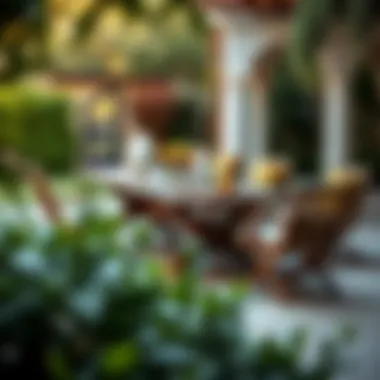
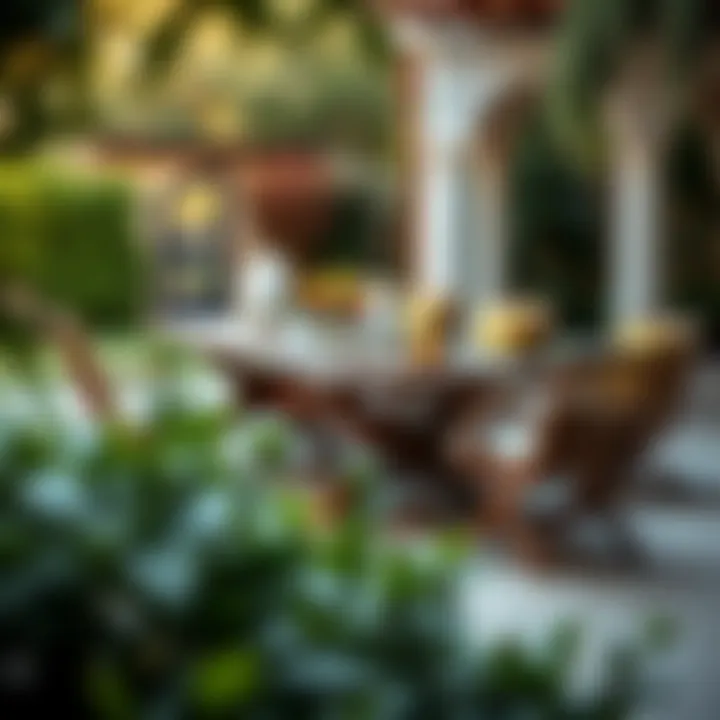
Intro
When it comes to enhancing outdoor living spaces, the right furniture can make a world of difference. This is where outdoor dining benches with cushions come into play, blending comfort and functionality in a sleek design. Not only do these benches elevate your alfresco dining experience, but they also add a touch of style to your patio or garden. This article aims to explore the various dimensions of these benches, covering everything from design trends to practical maintenance tips.
Furniture Design Trends
Current Styles and Themes
Outdoor dining benches have evolved tremendously, keeping pace with shifting tastes in home decor and garden aesthetics. Modern designs often embrace minimalism with clean lines, while rustic styles integrate natural materials like reclaimed wood. For instance, the Scandinavian design trend utilizes simple yet functional forms that emphasize light, airy spaces. With these trends, the benches don't just serve a purpose; they also become a statement piece of your outdoor area.
Color Palettes and Materials
Color choices are as varied as the styles themselves. From deep, earthy tones to bold, vibrant hues, the options are almost limitless. For instance, if your space leans toward natural beauty, consider muted greens or warm browns. Meanwhile, more adventurous homeowners might opt for benches in striking colors like teal or coral. Materials play a crucial role too; popular options include weather-resistant metals, durable plastics, and natural timbers. Often, cushions add another layer of style, available in an array of fabrics and patterns that can harmonize or contrast with the bench.
Practical Furniture Tips
How to Choose the Right Size
Selecting the proper size for your outdoor dining bench is like finding the perfect puzzle piece; it should fit seamlessly into your space. Measure the area where you plan to place the bench before making a decision. A good rule of thumb is to allow at least 24 inches of space per seat for comfortable dining. Furthermore, ensure that there is enough room for movement around the table and bench. It should feel cozy, not cramped.
Maintenance and Care for Longevity
Maintaining outdoor dining benches is less of a chore if you have a plan. Regular cleaning is essential; a mild soap and water solution works wonders for most materials. Cushion covers should be removable and washable, ensuring they stay fresh and inviting. Additionally, applying a weatherproof sealant to wooden benches can protect against harsh elements. This preventative care goes a long way in elongating the life of your furniture.
Remember, a well-maintained bench not only serves its purpose but also contributes to the overall aesthetic of your outdoor space.
Choosing the right outdoor dining bench with cushions is a thoughtful decision that can influence the way you and your guests enjoy the outdoors. It combines form and function while allowing for personal expression through design. Whether you lean toward sleek modernism or rustic charm, the world of outdoor dining benches is rich with possibilities.
Understanding Outdoor Dining Benches
Outdoor dining benches offer a unique blend of style and functionality, quickly becoming a staple for homeowners looking to elevate their outdoor spaces. These benches not only provide a comfortable seating option for al fresco dining but also enhance outdoor decor. Understanding the significance of outdoor dining benches helps in making informed choices that align with personal style and practical needs.
Definition and Purpose
An outdoor dining bench is typically a long seating piece designed for multiple people, often equipped with cushions for added comfort. These benches can serve as a primary seating solution alongside dining tables or can be used as standalone pieces for relaxation and socializing in gardens or patios.
Their purpose extends beyond mere seating; they create a welcoming atmosphere encouraging family gatherings and entertaining friends. Furthermore, their designs often harmonize with the surrounding environment, making an outdoor area feel complete. Depending on the material, color, and style chosen, these benches can become a focal point or subtly blend into the backdrop, enhancing the visual appeal of the space.
In essence, outdoor dining benches embody a functional elegance, permitting users to enjoy meals or conversations in fresh air. While they cater to practical seating needs, they also offer versatility—ideal for everything from casual breakfast nooks to formal dinner parties.
Historical Context
The concept of outdoor seating has roots that stretch back several centuries. Traditionally, benches were designed to offer respite in public spaces, parks, and gardens, inviting people to take a break from their daily routines. Cultures worldwide have used benches for both practical purposes and social gatherings, carving out moments of connection in outdoor settings.
Over time, outdoor benches have evolved significantly. In the early days, these pieces were usually crafted from heavy, durable materials such as hardwood, meant to withstand the rigors of outdoor use. As society moved towards outdoor entertaining and leisure, designers began experimenting with shapes, materials, and cushion options.
The introduction of innovative materials, like aluminum and composite plastics, reshaped how these benches are perceived in both style and functionality. Today, with the increasing trend towards outdoor living spaces, the outdoor dining bench has transformed into not just a piece of furniture but an expression of lifestyle, reflective of personal tastes as well as environmental considerations.
Design Elements of Outdoor Dining Benches
When setting the stage for alfresco dining, the choice of outdoor dining bench becomes vital. These benches do more than just provide a surface for sitting; they define the outdoor aesthetic and impact overall comfort during meals under the open sky. Each design element—from style to dimensions—plays a significant role in harmonizing with the existing outdoor space.
Styles and Aesthetics
Styles dictate not just the visual appeal of an outdoor dining bench but also influence the mood of your outdoor gathering. Here’s a closer look at specific styles that stand out in this arena:
Modern
Modern outdoor dining benches are characterized by clean lines and a sleek profile. These designs bring a contemporary flair that resonates well with minimalist architecture and the trend toward open spaces. One appealing aspect of modern benches is their adaptability; they often feature materials like stainless steel or molded plastics that rave about durability and ease of maintenance. However, one downside might be the lack of warmth that often accompanies more traditional designs, which could deter some homeowners seeking a cozy ambiance.
Rustic
Rustic styles shine through natural materials, especially reclaimed wood. Such benches tell a story and bring an earthy feel to outdoor arrangements. The key characteristic of rustic benches is their texture and imperfections, which blend beautifully with gardens or wooded areas. A unique feature of this style is its ability to evoke nostalgia and an inviting atmosphere. On the flip side, they might require a bit more maintenance to keep the wood from degrading in the face of the elements.
Minimalist
A minimalist outdoor dining bench embraces the "less is more" philosophy. Typically made from simple, unadorned materials, such as bamboo or concrete, these benches provide utility without unnecessary frills. Their key characteristic is functionality, often making them a smart choice for limited spaces. However, they can come off as stark or uninviting, so pairing them with vibrant cushions becomes essential to warm up the look.
Eclectic
Eclectic benches borrow design elements from various eras and styles, resulting in a vibrant and personalized piece. They can feature a mix of materials and colors, allowing homeowners to express unconventional tastes. This style invites creativity and opens the door to endless combinations, which can make your seating arrangements truly unique. However, achieving a cohesive look with eclectic designs might require a skilled eye; without careful planning, it can seem chaotic.
Dimensions and Space Considerations
When it comes to the dimensions of your outdoor dining bench, fitting it appropriately in your space is crucial. Measure your area and consider not just the bench’s length but also its height and depth. A standard dimension for dining benches often hovers around 18 to 20 inches in height, fitting standard dining tables comfortably. But don’t forget the need for extra space for elbow room and easy movement.
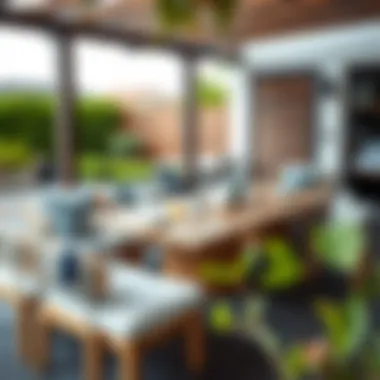
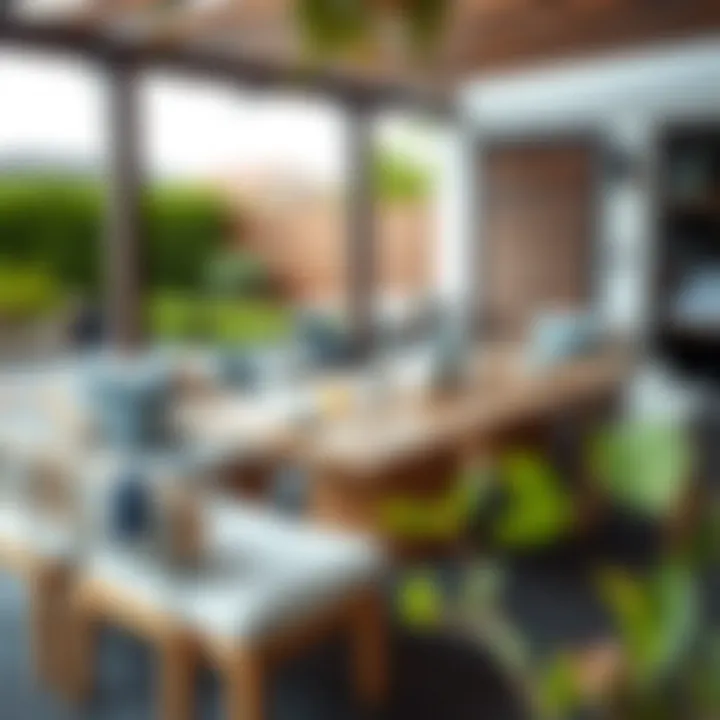
Furthermore, if you plan to add cushions, it’s wise to account for some added height. Therefore, flexibility in sizing is advantageous; choosing benches with removable legs can help accommodate different settings.
Creating a balance between aesthetics and functionality, a well-sized outdoor dining bench brings together comfort and style, making it an indispensable part of your outdoor gatherings.
Materials for Outdoor Dining Benches
The choice of materials for outdoor dining benches radically influences not only their aesthetic appeal but also their durability and ease of maintenance. Different materials bring unique characteristics, advantages, and challenges that should be carefully considered. Homeowners and designers are often torn between beauty and functionality, making it essential to understand the attributes of each option. Let’s explore some of the prevailing choices available in the market today.
Wood Options
Wood has been a popular choice for outdoor furniture owing to its classic beauty and versatility. Many types of wood can endure the elements, shaping your alfresco experiences.
Teak
Teak wood is like the golden child in the wood family. It is incredibly dense and resistant to water, which means it can handle the storms and sunshine without much fuss. The oil in the timber actually helps it fend off problems like warping and cracking, making it a beneficial choice for outdoor settings.
One key characteristic of teak is its rich golden hue, which naturally deepens to a charming silver-gray if left untreated. This unique feature adds an element of elegance to your outdoor dining area. While teak does come with a higher price tag, its longevity offsets the initial investment, resulting in a piece that withstands the test of time.
Cedar
Cedar, with its pleasant aroma, brings a warm and inviting vibe to outdoor spaces. Known for being lightweight, this wood is straightforward to move around as needed. Cedar is naturally resistant to decay, which means it stands up quite well under outdoor conditions.
One key characteristic of cedar is its resistance to insects, allowing it to remain intact longer without the need for chemical treatments—always a plus for those of us concerned about using harmful substances in our yards. However, it may require regular staining or sealing to maintain its rich color and to prolong its life span, which can be a small nuisance, but manageable.
Eucalyptus
Eucalyptus is another sturdy option that does not leave you feeling light in the pocket like some of the high-end woods do. It has a striking appearance that resembles teak but is available at a fraction of the cost. This tough wood is actually a sustainable choice, growing quickly and abundantly in the right environments.
The key characteristic of eucalyptus is its high density, making it resistant to harsh weather conditions. However, one unique feature is its tendency to change color if not protected properly—from a rich brown to a silvery-gray. This means it might require some upkeep to maintain that dazzling appearance, making it a good fit for those who are optimistic about regular care.
Metal Frame Choices
Metal benches have gained popularity for their robust construction and modern aesthetic. Whether you lean toward aluminum, steel, or iron, each option evokes a unique style that can enhance your outdoor living space.
Aluminum
Aluminum is lightweight and corrosion-resistant, making it a smart choice for outdoor benches. It effortlessly combines style and endurance. One notable aspect of aluminum is its versatility—it can be easily molded into various stylish designs, making it appealing for modern or minimalist settings.
The unique feature of aluminum is how it can be treated with finishes that mimic the look of more expensive metals. This means you can achieve that high-end feel without the high-end price. However, while it handles rust well, it might not withstand impacts as well as other materials.
Steel
Steel benches pack a powerful punch when it comes to sturdiness. If you’re looking for durability, steel is a top contender. Its strength makes it suitable for public spaces or areas with heavy usage.
One key characteristic of steel is its sleek finish that can elevate your outdoor decor. The unique feature, however, is that it will need some protection against the elements, like rust, so it’s wise to look for weather-resistant finishes. This maintenance can be seen as a con, but many appreciate the solidity that steel offers.
Iron
Iron has a traditional charm that brings an almost romantic feel to outdoor spaces. Its heaviness means it can withstand stronger winds, making it excellent for coastal areas. One major characteristic of iron is its unrivaled durability, which makes it a reliable choice for outdoor usage.
However, the drawback comes in its tendency to rust if not coated properly. Moreover, it can be quite heavy, making it hard to relocate if you change your mind about your outdoor layout. Still, for those who enjoy classic aesthetics, iron’s substantial nature can add a desirable touch of history.
Plastic and Composite Materials
Plastic and composite materials are now making their mark in the outdoor furniture arena, offering alternatives that are budget-friendly and low-maintenance. These materials often mimic the look of wood while being highly resistant to moisture and fading.
Plastic options are durable, lightweight, and available in an array of colors, allowing for a vibrant look in your outdoor settings. Composite materials, deriving from recycled products, are even better for the environmentally-conscious homeowner looking to furnish their space sustainably.
The unique feature of composite materials is their resistance to staining and fading, which can save you time and effort in maintenance. However, some may find the aesthetic lacks the overall warmth and charm of classic wood or metal designs. While they may serve practical purposes well, they can feel less cozy, leaving room for debate among enthusiasts.
The Role of Cushions
When considering outdoor dining benches, the role of cushions cannot be overstated. Cushions add layers of comfort and flair, transforming a simple bench into a cozy haven for relaxation and enjoyment. They enhance the overall experience by providing essential support during meals or leisure activities while also elevating aesthetics. After all, no one wants to sit on a hard surface for extended periods. Moreover, with the right cushioning, even marathon brunches or lengthy evenings spent outdoors can be enjoyable.
Comfort and Support
Cushions serve a vital function in promoting comfort and support. When seated on a well-cushioned bench, individuals are less likely to feel fatigued or restless. This is especially important during gatherings, where friends and family tend to linger over food and conversation. High-quality cushions help maintain proper posture, reducing strain on the back and hips. Combining physical support with the right thickness ensures that cushions are neither too soft nor too firm, helping sat back issues for users of varied sizes and ages.
Fabric Choices and Durability
Cushions also vary widely in material, making this a key consideration when purchasing outdoor dining benches. Choosing the best fabric is important to ensure longevity, comfort, and maintenance ease.
Weather-resistant Fabrics
Weather-resistant fabrics are largely recommended for outdoor use. These materials, like acrylic or polyester blends, are typically water-repellent and UV-resistant, contributing to their appeal in outdoor settings. The key characteristic of weather-resistant fabrics lies in their ability to withstand sun exposure without fading, ensuring they maintain their charm over time. For a homeowner, it's a wise investment.
Unique features of these fabrics include:


- Fade resistance: They stay vibrant despite prolonged sun exposure.
- Water repellency: They help prevent mildew growth and moisture retention.
However, these fabrics can come with a higher price tag compared to regular upholstery options. Still, the long-term benefits outweigh the initial cost, making them a popular choice for anyone serious about maintaining their outdoor seating arrangements.
Ease of Cleaning
When selecting cushions for outdoor benches, ease of cleaning should also be front of mind. Fabrics that can be wiped down or machine-washed save time and effort, allowing homeowners to enjoy their outdoor space without the worry of stubborn stains.
Key characteristics of easy-cleaning cushions include:
- Stain-resistant coatings: These treatments help protect against spills, making upkeep simpler.
- Removable covers: Cushions with zippers allow for hassle-free washing.
The unique feature of ease of cleaning lies in not just maintaining appearance but also promoting hygiene, especially in settings where food is consumed. Outdoor dining areas invite crumbs and spills, so quick cleaning solutions are sought-after.
Color and Pattern Considerations
Finally, the choice of color and pattern for cushions plays a fundamental role in the overall design scheme. Bright hues can make a statement, while subdued tones exude sophistication. Matching the cushion colors with surrounding decor enhances the outdoor aesthetic and can create visual harmony in the outdoor living space.
Functional Benefits of Outdoor Dining Benches
Outdoor dining benches with cushions bring a myriad of functional benefits that go beyond mere aesthetics. In this section, we will examine how these benches enhance outdoor experiences, ultimately enriching both leisure and collaborative dining environments. From optimizing space to providing versatile solutions for various occasions, understanding these benefits helps prospective buyers make well-informed decisions.
Space Efficiency
One of the standout features of outdoor dining benches is their space efficiency. Unlike traditional chairs that often clutter dining areas, benches offer a streamlined seating solution that can be adjusted to fitted different group sizes. When you have a gathering, you can snugly tuck a couple of kids and adults on a single bench without crowding the table; it’s a real space-saver. This is particularly advantageous for smaller patios or balconies where every square inch counts.
Consider this scenario: Imagine a summer barbecue where tables overflow with platters of food, and kids are scampering about. Using benches instead of multiple chairs allows you to optimize your available space and creates a more communal atmosphere, where everyone feels connected. Moreover, benches can easily be aligned against walls or placed under awnings when not in use, maintaining a clean look while saving room.
To illustrate the idea, here are some key space efficiency aspects:
- Accommodating More People: Benches can seat more individuals than individual chairs, enabling larger gatherings without requiring additional seating.
- Flexible Arrangements: Easily move benches to adapt to various layouts and seating requirements, whether for intimate dinners or larger celebrations.
- Multi-functional Use: When not serving a dining purpose, benches can act as a decorative feature or a platform for potted plants or outdoor cushions, maximizing utility.
Versatility and Use Cases
The versatility of outdoor dining benches cannot be overstated. They aren’t just for dining; these benches excel in providing functional seating in numerous settings. A thoughtful combination of style and purpose allows you to adapt your outdoor area for different occasions.
Use Cases of outdoor dining benches include:
- Casual Family Dinners: When gathered for a meal, benches offer a warm, informal feel. A cushioned bench can make everyone feel at ease, encouraging long chats over lingering meals.
- Social Gatherings: Benches are perfect for social events, like parties or neighborhood barbecues, where guests may come and go freely. The ability to rearrange seating on a whim adds to their appeal.
- Creative Spaces: They can serve as a makeshift lounge spot for outdoor movie nights or as additional seating for relaxing with drinks after a long day, proving handy when you have friends over for game night.
- Gardening or Outdoor Work Areas: Benches with storage can also serve a dual purpose. Some designs have hidden compartments, perfect for keeping gardening tools handy while providing a spot to sit during your projects.
Caring for Your Outdoor Dining Bench
Taking care of your outdoor dining bench with cushions is not just about keeping it looking good. It's a matter of prolonging its life, ensuring comfort, and maintaining an inviting atmosphere in your outdoor space. Investing in quality furniture is all well and good, but without proper care, it can easily become a source of frustration. A superficial clean won’t do; understanding the materials and the environment is key.
Benches placed outdoors face a barrage of elements—rains, sun, snow, and sometimes even the curious eyes of nature's critters. By developing a simple care routine, you can enhance durability and comfort while preventing potential wear and tear.
"An ounce of prevention is worth a pound of cure." Taking the time to properly maintain your bench can save a lot of heartache later.
Cleaning Guidelines
Regular cleaning is pivotal in keeping your outdoor dining bench looking spick and span. The frequency might depend largely on your geographical location and the specific weather conditions. Here’s a straightforward list of cleaning guidelines that can keep your bench from looking like it’s been through the wringer:
- Remove debris regularly: Dust, leaves, and other remnants can build up and cause damage. Wipe the surface with a soft, dry rag or a soft-bristle brush. If you let dirt settle in, it can scratch or dull materials over time.
- Use the right cleaning solution: Depending on whether your bench is wood, metal, or plastic, the right cleaner matters. For wooden benches, a mix of warm soapy water works wonders. Metal? A mild detergent should be enough. Avoid abrasive brushes; they can scratch surfaces, especially with painted metals or finishes.
- Pay attention to cushions: Wash the removable covers according to their care instructions, and regularly check for wear and tear. If not removable, a vacuum cleaner can effectively remove crumbs and dust, while a damp cloth can help with stains.
- Dry thoroughly: If you've cleaned your bench, ensure it's completely dry before using it again. Leaving moisture can lead to mold, especially with wooden benches.
Implementing these cleaning tips will not only keep your bench functional but also greatly enhance your outdoor dining experience.
Seasonal Maintenance
Seasons change, and so do the challenges they pose to your outdoor furniture. Handling seasonal maintenance is crucial in safeguarding your outdoor dining bench and cushions, ensuring longevity and comfort.
- Spring Cleaning: After winter, it's essential to check your furniture for any damage that may have occurred during the colder months. Examine for any loose bolts, splintered wood, or corrosion on metal surfaces. Give the bench a thorough clean, and consider applying a protective sealant to enhance wood surfaces against moisture.
- Summer Care: During the summer, sun protection becomes paramount. Placing your bench in shaded areas or using covers when not in use can minimize sun damage. Cushions should be sprayed with fabric protectants designed to repel water and resist fading to maintain their look and function throughout the hot months.
- Fall Prep: As leaves begin to fall, ensure that the bench is free of debris and moisture. Consider storing the cushions indoors to protect them from dampness and temperature fluctuation, which can deteriorate the material.
- Winter Storage: If winters are harsh in your area, storing your bench indoors or covered will protect it from snow and ice. If covered, ensure the cover is breathable to prevent moisture buildup underneath, which can lead to mold and mildew.
In essence, maintaining your outdoor dining bench through regular cleaning and seasonal care is a worthy investment in comfort and aesthetics. With the right approach, you can enjoy your external dining space year after year.
Incorporating Outdoor Dining Benches into Decor
Outdoor dining benches with cushions have become a staple in creating inviting outdoor spaces. Their utility goes beyond mere seating; they play a pivotal role in enhancing aesthetics while maximizing comfort during gatherings. As we explore this section, we will cover how these benches can complement various pieces of furniture, contributing to a coherent outdoor atmosphere.
Complementary Furniture Pieces
Dining Tables
When discussing outdoor dining setups, dining tables naturally come to mind. A well-matched dining table not only provides a functional surface for meals but also anchors the overall design of an outdoor area. Choosing a table that complements the style of the bench is crucial. For instance, a rustic wooden dining table pairs beautifully with a similarly styled bench, creating a warm and welcoming vibe. When selecting dimensions, consider the bench length; ideally, it should allow for ample space for diners while promoting a casual, relaxed feel. This harmony turns a simple seating arrangement into a cohesive gathering spot where conversation flows as smoothly as the evening breeze.
Consider this a vital aspect of your outdoor arrangement: the finish of the dining table can either elevate or diminish the visual appeal. Key characteristics to keep in mind include durability and resistance to weather elements. A well-designed, high-quality table can last years with minimal wear, a significant advantage for any homeowner looking to invest wisely in outdoor furniture.
Umbrellas
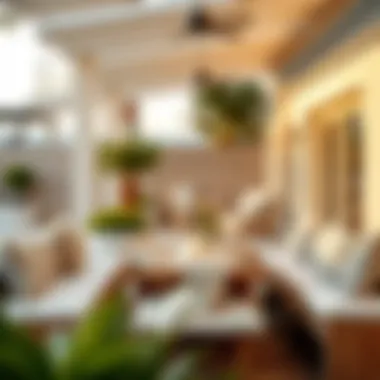

Merely placing a dining bench and table outside is often not enough. The umbrellas used in these setups can dramatically affect both style and function. A well-placed umbrella provides essential shade, ensuring that your meals remain comfortable under the sun. When looking for an umbrella, size plays a decisive role; a larger canopy can protect multiple seating areas, offering delightful relief on those scorching summer days.
Another unique feature of umbrellas is their variety of designs and colors. From vibrant hues to more neutral tones, the options available allow homeowners to match or contrast with their existing decor. This flexibility in style makes umbrellas a popular choice for those wanting to personalize their outdoor space while keeping practicality in mind. One must, however, consider the disadvantages, such as the need for regular setup and takedown, which can sometimes be a hassle, but the benefits far outweigh these minor inconveniences.
Fire Pits
Adding fire pits into the equation shifts the focus from just dining to creating a multifunctional outdoor escape. These popular features serve as a focal point around which families and friends can congregate, offering warmth and ambiance during chilly evenings. A well-placed fire pit complements an outdoor dining bench by providing a cozy element for post-dinner relaxation.
The characteristic of fire pits being available in various shapes, sizes, and materials means you can find one that fits seamlessly into your existing decor. A circular, stone fire pit pairs well with rustic benches, which can enhance the overall aesthetic while providing comfort. However, safety is a consideration; ensuring that the fire pit is appropriately distanced from flammable materials is essential to enjoy it safely and responsibly.
Creating a Cohesive Outdoor Space
An outdoor area flourishes when all elements work together harmoniously. Integrating benches, tables, umbrellas, and fire pits into one design means considering colors, materials, and styles in every choice.
- Assess the materials: Natural woods, metals, or composites can dictate the feel of your space.
- Color selection: Matches or contrasts can create visual interest but must not clash.
- Layout: Ensure furniture facilitates movement, promoting a welcoming environment for guests.
By thoughtfully combining these elements, outdoor dining benchtops become more than just seating; they evolve into distinct portions of a larger, inviting space that beckons people to linger and enjoy the surroundings.
Choosing the Right Outdoor Dining Bench
Selecting the right outdoor dining bench is not just about picking a piece of furniture. It’s about creating an experience, a space where meals turn into memories. A well-chosen bench can elevate your alfresco dining, making it a hit amongst family and friends. In this section, we will dive into what to consider when choosing the perfect outdoor dining bench, ensuring you make a choice that speaks to your needs and enhances your outdoor environment.
Factors to Consider
Size of the Space
When it comes to outdoor areas, size matters. The dimensions of your space directly influence the type of bench that will fit well. It's about finding a sweet spot where the bench complements rather than overwhelms. A well-fitted bench can turn a chaotic garden into a tranquil sanctuary, making it a center for gathering.
- Key Characteristic: The size of the space dictates placement options. A snug patio might only accommodate a slim, streamlined design, while a spacious backyard could invite a more robust seating arrangement.
- Why it's Beneficial: Getting the proper size means more than comfort; it means creating a harmonious ecosystem outdoors. When a bench is too large, it can obstruct pathways or make the area feel cramped; too small, and it might get lost in the expanse.
- Unique Feature: Adjustable benches are becoming more popular, allowing for flexibility in layout. This can be particularly advantageous for those who often entertain or vary the space's use over time.
Budget
Every choice comes with a price tag attached. Your budget lays the groundwork for what options you’ll have on the table—or in this case, the bench. Outdoor dining benches can range from affordable options to premium, designer selections.
- Key Characteristic: The budget can either limit or expand your choices. It's crucial to decide what you’re willing to spend before browsing, which prevents disappointment later on.
- Why it's Beneficial: Adhering to a budget helps you manage expenses and fosters smarter purchasing decisions. It encourages you to look beyond brands and focus on quality and durability.
- Unique Feature: Many retailers offer sales or special promotions seasonally—taking advantage of these can stretch your funding further while still allowing for quality options.
Usage Frequency
How often do you foresee using this bench? This aspect is significant, especially when considering the materials and construction. A bench that sees constant use should live up to the demands—and perhaps even the weather.
- Key Characteristic: A frequently used bench needs durability and comfort. If it’s going to see many meals and gatherings, opt for sturdier materials that can withstand wear.
- Why it's Beneficial: Understanding usage can help in choosing the right materials and cushion types. For example, a bench that’s meant for casual use might prioritize aesthetics over sturdiness, while a daily meal spot would need to be as tough as nails.
- Unique Feature: Some cushions are designed for heavier usage, featuring waterproof materials or easy-to-clean fabrics, which is an added bonus if stains are likely.
Selecting an outdoor dining bench involves key factors — size, budget, and usage frequency. These elements provide a foundation for a thoughtful purchase that complements your outdoor living space.
In summary, thinking critically about these factors can significantly enhance your choice and lead you toward a bench that not only meets your needs but also enriches your outdoor dining experience.
Trends in Outdoor Seating
The outdoor living space has evolved over the years into a vital extension of the home. This makes the trends in outdoor seating particularly important. Homeowners are not just looking for functionality; they are also seeking stylish, comfortable, and sustainable options. From cozy backyard dinners to lavish garden parties, the choices available can significantly enhance outdoor experiences.
Emerging Styles
As seasons change, so do the styles that dictate outdoor seating arrangements. Among the most noticeable trends are the following:
- Mix and Match: Gone are the days when matching patio sets were the norm. People are embracing a more eclectic approach by combining different styles. For instance, pairing a modern sleek aluminum dining bench with classic wooden chairs creates a charming and personalized atmosphere.
- Natural Materials: There is a pronounced shift toward natural and organic aesthetics. Benches made from reclaimed wood or sustainably sourced materials are capturing attention. Not only do they offer a rustic charm, but they also appeal to the eco-conscious consumer.
- Bold Colors: Vibrant hues are dominating outdoor spaces. Bright cushions paired with neutral benches can invigorate an otherwise drab garden. Likewise, benches painted in striking shades become conversation starters and focal points.
- Multi-functional Designs: With a space crunch in urban settings, homeowners are gravitating toward benches that serve multiple purposes. For example, a bench that doubles as storage is gaining traction. This not only saves space but maximizes functionality.
In the realm of outdoor seating, trends are constantly evolving, mirroring the shifts in lifestyle and preferences.
Sustainability in Furniture Design
In recent years, sustainability has become a buzzword in furniture design, particularly for outdoor seating. As more consumers become aware of their environmental impact, the demand for eco-friendly products has surged. Here’s what to consider:
- Materials Matter: Selecting benches made from sustainable materials is crucial. For instance, bamboo is not only a renewable resource but also known for its durability. Similarly, recycled plastic offers longevity without contributing to landfill waste.
- Local Sourcing: Supporting local artisans who use regionally sourced materials decreases carbon footprints. This gives a unique story to each piece, making it more than just furniture.
- End-of-Life Considerations: More designers are now creating furniture with its end-of-life in mind. Opting for products that can be easily recycled or repurposed promotes a circular economy. For instance, benches with removable cushions can allow for cushion upgrades without discarding the entire frame.
"Sustainable design isn't just about the materials; it's about the entire lifecycle of the product."
- Durability and Maintenance: Investing in high-quality materials reduces the frequency of replacements. Benches created from weather-resistant materials, such as treated metals or solid woods, will often endure the wear and tear, leading to less waste overall.
Ultimately, the trends in outdoor seating not just cater to aesthetics, they create a bridge connecting style, comfort, and environmental consciousness. This comprehensive awareness helps homeowners choose outdoor furniture that aligns with their values and lifestyle.
Closure
The significance of outdoor dining benches, especially those cushioned for comfort, cannot be understated. Beyond mere functionality, these benches serve as pivotal elements that transform outdoor spaces into inviting areas meant for gathering and relaxation. As discussed throughout this article, the considerations around design, materials, and maintenance all culminate in creating a seating solution that enriches the alfresco dining experience.
Encapsulating the Importance of Outdoor Benches
These benches contribute not just to practical seating arrangements but also to the aesthetic appeal of outdoor environments. When thoughtfully integrated into garden layouts, patios, or balcony designs, they become more than just furniture; they are about style and comfort.
Factors that elevate the significance of outdoor benches include:
- Comfort: Cushions provide the softness needed for extended seating, making projects like summer barbecue parties more enjoyable.
- Versatility: They adapt to a wide range of uses, from casual meals to social gatherings, proving useful season after season.
- Aesthetic Contribution: A well-chosen dining bench can be a focal point, enhancing the overall look of the outdoor space.
Furthermore, these benches allow for adaptability in different environments, be it a cozy nook in a sprawling garden or a compact area on a city balcony. They help maximize space efficiency while remaining stylish.
Ultimately, the careful selection and incorporation of outdoor dining benches can significantly increase both the beauty and functionality of outdoor living areas. Such choices reflect a thoughtful approach to design that caters to the evolving needs of homeowners, decorators, and anyone looking to elevate their outdoor experience.



